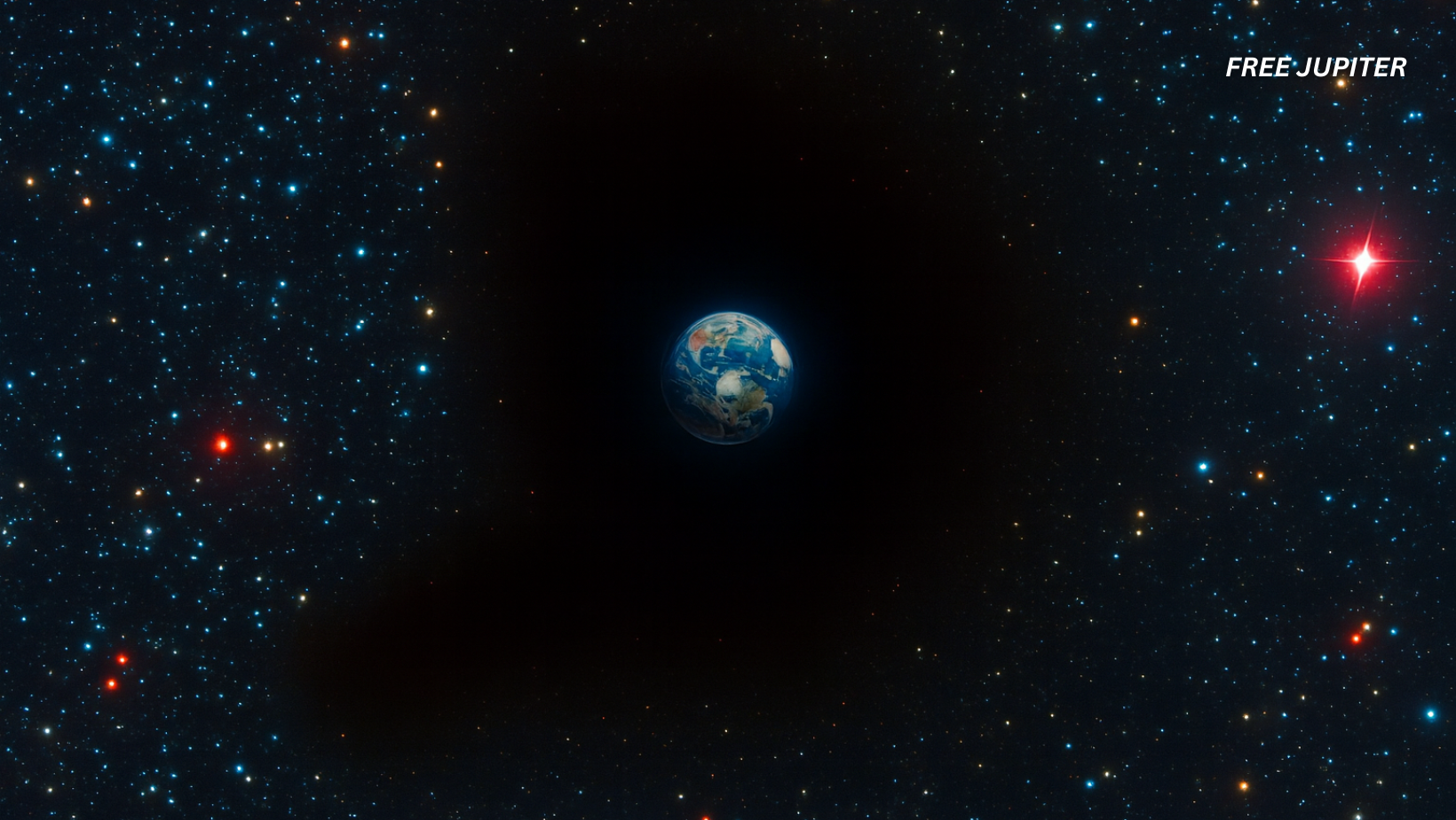Friendly Note: FreeJupiter.com is a place for curious minds and fun discoveries 🌌✨ But we’re a general information site, not a medical guide. Always double-check the facts—and when it comes to your health, check in with a professional too! 💙
Space has always carried a sense of unease for humans. It’s not just the silence or the unimaginable distances—it’s the emptiness. And now, astronomers say that emptiness may be even more unsettling than we realized.
A team from the University of Portsmouth in the UK suggests that Earth, our Solar System, and even the entire Milky Way galaxy could be floating inside a massive cosmic void—a bubble-like hole in the fabric of the Universe.
This isn’t just a wild thought experiment. The “bubble” hypothesis was introduced to help solve one of the most pressing mysteries in cosmology: why the Universe appears to be expanding at two different speeds.
The Strange Case of the Expanding Universe
In the 1920s, Edwin Hubble discovered that the Universe is expanding, a revelation that flipped astronomy on its head. By measuring how galaxies move away from us, scientists were able to estimate the rate of this expansion—something now called the Hubble constant.
But here’s the catch: not everyone agrees on the value of this constant. Depending on how and where you measure it, you end up with two answers:
- Nearby galaxies show the Universe expanding faster.
- Distant light from the early Universe—measured using the cosmic microwave background (CMB)—shows it expanding slower.
This mismatch is what astronomers call the Hubble tension or Hubble crisis. It’s not a small error, either. The two values are far enough apart that something in our model of the Universe might be fundamentally missing.
Read more: Astrophysicist Suggests Sending a Spacecraft to Visit a Black Hole
A Cosmic Bubble as a Possible Solution
Dr. Indranil Banik, who presented the idea at a Durham astronomy conference, suggests that the Milky Way sits near the center of a giant, billion-light-year-wide void. Inside this bubble, galaxies would be slightly less dense—around 20% fewer than in the average Universe.
This matters because emptier regions expand faster. Imagine baking raisin bread: as the dough rises, the raisins (galaxies) spread apart. But if you find a patch of dough with fewer raisins, it will puff up more quickly than the dense parts.
If we really do live in such a cosmic “low-density zone,” then it could explain why measurements taken nearby show a faster expansion compared to those from faraway parts of the Universe.
The Evidence: Ripples from the Big Bang
This isn’t just speculation. Banik’s team looked at baryon acoustic oscillations (BAOs)—fossil-like ripples in the distribution of matter that date back to the Big Bang. Think of them as the ancient “sound waves” of the early Universe, frozen into its structure.
By studying how these ripples line up with the distribution of galaxies, astronomers can map out the large-scale geometry of the cosmos. Banik’s findings suggest the void model was about 100 million times more likely than a Universe without such a void.
That’s a jaw-dropping statistical boost in favor of the bubble idea. Still, not everyone in the scientific community is ready to pop champagne just yet.
Why the Void Idea Is Controversial
The standard cosmological model—the “big textbook” of how we think the Universe works—assumes that matter, on the largest scales, should be distributed fairly evenly. While local clusters and voids exist, the big picture should look smooth.
A billion-light-year-wide under-dense region challenges that assumption. Some astronomers worry it could throw off decades of carefully constructed theory. Others see it as an exciting opportunity to rewrite the rules.
For now, the void theory is one possibility among many. Some scientists argue the discrepancy could instead point to new forms of physics, adjustments in how we calculate dark energy, or even undiscovered properties of dark matter.
Read more: Rogue Planets Floating in Deep Space May Be Forming Their Own Moons
Related Cosmic Mysteries
The void hypothesis fits into a long tradition of cosmic puzzles that remind us how little we truly know about the Universe.
1. The Great Attractor
In the 1980s, scientists discovered that our Milky Way is being pulled toward a mysterious gravitational hotspot called the Great Attractor. Despite decades of research, its exact nature remains unclear—it may be a hidden supercluster of galaxies, or something even stranger lurking behind the Milky Way’s dust.
2. Dark Energy and the Accelerating Universe
In 1998, two independent teams found that the Universe’s expansion isn’t slowing down but actually speeding up. This shocking discovery led to the concept of dark energy, a mysterious force that seems to make up about 70% of the cosmos. If voids influence our measurements of expansion, they could also force scientists to rethink how much dark energy is truly out there.
3. Cold Spots in the Cosmic Microwave Background
The CMB—the faint afterglow of the Big Bang—shows strange “cold spots” where the radiation is weaker than expected. Some scientists have suggested these could be linked to giant voids in the Universe, similar to the one Banik describes. If so, these cold spots might be further evidence that the cosmos is more patchy than we thought.
What Would It Mean for Us?
If Earth is inside a giant bubble, does it change anything about our daily lives? Not really. Living inside a void doesn’t affect gravity on Earth, our weather, or our ability to survive.
What it does change is how we understand the Universe. If confirmed, this discovery would reshape calculations about its age, its structure, and perhaps even its ultimate fate. It would also remind us that our cosmic neighborhood isn’t “average”—we’re in a special patch of space that expands differently from others.
In a way, it’s humbling. We already knew Earth isn’t the center of the solar system, and the Milky Way isn’t the center of the Universe. But what if our galaxy happens to sit in a strangely empty region? That would make our cosmic address even more unique.
Read more: Astronomers Are Baffled by a Space Object Flashing in Both Radio Waves and X-Rays
The Bigger Picture
The idea of a cosmic bubble might sound like science fiction, but it reflects a broader truth: the Universe is still full of mysteries. Every answer we uncover seems to open ten new questions.
Whether or not the void theory holds up, it highlights just how much we still don’t know. The cosmos isn’t just a vast expanse of stars—it’s a puzzle still waiting to be solved, with pieces we haven’t even discovered yet.
So, are we living in a billion-light-year-wide bubble? The evidence is growing, but the debate isn’t settled. What’s certain is that the next few years of cosmology will be anything but boring.
After all, space may be empty—but it’s never dull.
Image: GPT/5o.










